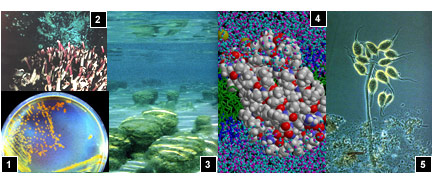|
|

|


|

^ Program

Computational Astrobiology and the Origins of Life
    
|
|

• Biomolecular Origins and Functions
• Computational Astrobiology
• BioInformatics
|

Co-Leads: Andrew Pohorille (Computational Astrobiology),
Lou Allamandola, Max Bernstein (Origins of Life)
|
Purpose
NASA University (NASA U) provides resources from its hub to support this ten week internship program in Computational Astrobiology and related theoretical investigations on the origin of life. Individual research projects address all seven goals of the Astrobiology Roadmap, but focus on the Origins of Life (goal 3), Life in our Solar System (goal 2), Evolution, Environment and the Limits of Life (goal 5) and Life's Future on Earth and Beyond (goal 6).

1. Origins of life and limits of life studies overlap, since the extremes of life provide evidence of how life might have endured space travel or originated in the extreme conditions on early Earth. Extremophile bacteria Deinococcus radiodurans (D. rad) can survive extreme levels of radiation, dehydration, extreme temperatures, and exposure to genotoxic chemicals.
2. Tubeworms in the the boiling water of thermal vents are home to bacteria, which thrive at these temperatures and may provide clues to the origin of life. 3. Stromatolites survive as our earliest fossil record of life on early Earth some 3.8 billion years ago. 4. Simulations of cellular proteins M2 protein in a membrane. Through simulation experiments, Andrew Pohorille’s group studies membrane behavior. 5. The Fruiting Body is one of the most primitive examples of collaboration; one-celled organisms are attracted to form a community, which generates this fruiting body.
|
Background
Astrobiology integrates many disciplines and so is an ideal testbed for cross-disciplinary scientific and engineering collaboration. Geologists study how the Earth evolved and when it might have had the constituents for life. Paleontologists examine the fossil record. Chemists form hypotheses about what kind of chemistry might have made the leap from non-life to life and how that process might have occurred. Astronomers seek other planetary systems where life might exist.
Biologists look at replication and metabolism in biological systems and imagine what their precursors might have been. Computer scientists construct simulations to see what emerges from artificial evolution in the ecosystems they build. Physicists wonder if the key to life's origin lies in the physics of far-from-equilibrium systems, or in that pervasive force that played a key role in forming our universe - gravity. Newer sciences, such as information theory and complexity theory, explore astrobiology questions from their theoretical perspectives, harnessing tools like cellular automata and artificial life. And this only samples the surface.
In 2004 this module, offered by the NASA Center for Computational Astrobiology and Fundamental Biology (NCCAFB) directed by Andrew Pohorille, enables Research Associates to work on a range of computational astrobiology questions. The objective is to give them the opportunity to perform theoretical and computational research in a variety of areas that reflect the breadth of computational astrobiology.
A group of 8-12 students with diverse backgrounds, ranging from biology to chemistry, astrophysics, mathematics and ecology, is selected based on their academic merit. Students spend 10 weeks at Ames working on individual research projects. Before arriving at Ames they are assigned mentors and projects that match their interests and skills. The projects are chosen such that at the end of the internship each participant accomplishes tangible results, which are presented in a publication-style report. Research Associates also participate in a series of joint activities that expose them to the broad range of science being done at NASA Ames.
Each summer the program pursues several projects in computational astrobiology, devoted to advancing our understanding of the origin, evolution and distribution of life in the Universe. Examples: Quantum chemical studies were performed on possible reactions of melatonin with reactive nitrogen and on complexes of biological molecules and water. A web interface was created to couple existing spectroscopic data with spectrum synthesis codes, providing ready access to high accuracy theoretical spectroscopy. One team studied the structure of a young circumstellar disk, accreting material from its parent cloud. Another investigated learning mechanisms for the control of robotic devices. Still another developed a microarray-based fungal identification system. Another investigated the structure of an ATP-binding protein using Rosetta.
Computational astrobiology enables development of bioinformatics resources, studies on the origins and evolution of life, and space genomics (including the effects of gravity on gene expression). For a list of projects, reports, and more information on the NASA Center for Computational Astrobiology and Fundamental Biology see the NCCAFB web site.
|
|

|

